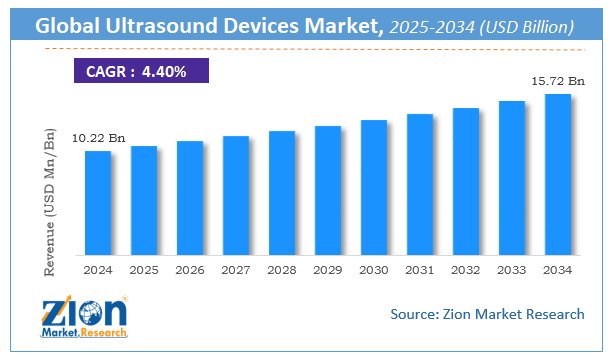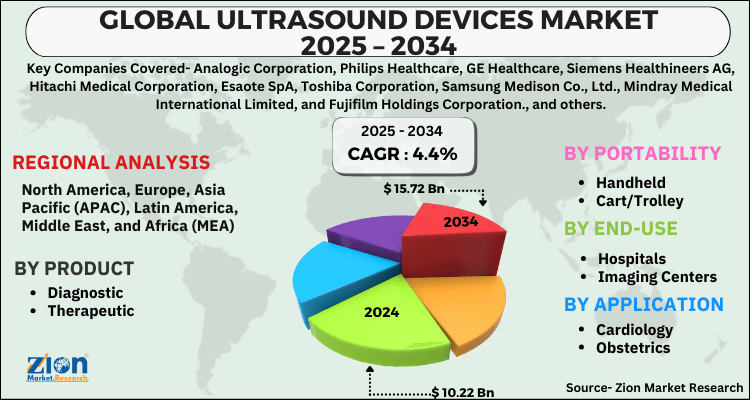Global Ultrasound Devices Market Size, Share, Growth Analysis Report - Forecast 2034

Ultrasound Devices Market By Product (Diagnostic and Therapeutic), By Portability (Handheld and Cart/Trolley), End-Use (Hospitals, Imaging Centers, and Research Centers), Application (Cardiology, Obstetrics, Orthopedics, Vascular, and General Imaging), and By Region: Global and Regional Industry Overview, Market Intelligence, Comprehensive Analysis, Historical Data, and Forecasts 2025 - 2034
| Market Size in 2024 | Market Forecast in 2034 | CAGR (in %) | Base Year |
|---|---|---|---|
| USD 10.22 Billion | USD 15.72 Billion | 4.4% | 2024 |
Ultrasound Devices Market Size And Industry Analysis
The global ultrasound devices market size was worth around USD 10.22 Billion in 2024 and is predicted to grow to around USD 15.72 Billion by 2034 with a compound annual growth rate (CAGR) of roughly 4.4% between 2025 and 2034. The report analyzes the global ultrasound devices market's drivers, restraints/challenges, and the effect they have on the demands during the projection period. In addition, the report explores emerging opportunities in the ultrasound devices industry.
Ultrasound Device Market: Outlook
Ultrasound has enhanced its reach from diagnostic realm towards alternative modes of treatment for uterine, cardiac soft tissues, and breasts. In addition to this, ultrasound equipment provides non-invasive diagnostic pictures for decades. Currently, tiny and portable healthcare ultrasound equipment has been produced. Furthermore, in recent year’s miniature-sized ultrasound devices are manufactured and they can be carried by physicians in their pockets. This hand-held equipment is cost-efficient in comparison to other high- end ultrasound medical systems, thereby prompting business growth. Large-scale utility of pocket-sized ultrasound devices in diagnosing shoulder pathology will provide impetus to expansion of ultrasound device industry.
Key Insights
- As per the analysis shared by our research analyst, the global ultrasound devices market is estimated to grow annually at a CAGR of around 4.4% over the forecast period (2025-2034).
- Regarding revenue, the global ultrasound devices market size was valued at around USD 10.22 Billion in 2024 and is projected to reach USD 15.72 Billion by 2034.
- The ultrasound devices market is projected to grow at a significant rate due to increasing demand for non-invasive imaging, technological advancements, and rising prevalence of chronic diseases.
- Based on Product, the Diagnostic segment is expected to lead the global market.
- On the basis of Portability, the Handheld segment is growing at a high rate and will continue to dominate the global market.
- Based on the End-Use, the Hospitals segment is projected to swipe the largest market share.
- By Application, the Cardiology segment is expected to dominate the global market.
- Based on region, North America is predicted to dominate the global market during the forecast period.
Ultrasound Device Market: Growth Dynamics
Expansion of ultrasound device industry over forecasting timeline is owing to its easy availability and portable nature. For instance, hand-held ultrasound equipment with new features is easily available across globe. Moreover, few of hand-held ultrasound devices possess transducer and screen connected as a unit, while others have transducer connected with smartphones or tablets. Additionally, some of them are wirelessly connected. Furthermore, hand-held ultrasound equipment is successfully tested for myriad medical applications including emergency care and ward-based supplements. This, in turn, will create new growth opportunities for ultrasound device industry.
In addition to this, surging government investment in research activities for ultrasound imaging and rise in healthcare service providers will enlarge scope of ultrasound devices market. Furthermore, surging incidences of chronic ailments can provide impetus to expansion of ultrasound devices industry. Incidences of cancer have translated into humungous demand for diagnostics, thereby resulting into sizable expansion of ultrasound devices industry in ensuing years. New product launches will favorably leverage ultrasound devices market earnings. For instance, in September 2020, Philips Healthcare launched latest version of cardiovascular ultrasound services referred as Affiniti CVx that assist physician in offering effective patient care services.
Ultrasound Devices Market: Segmentation Analysis
The global ultrasound devices market is segmented based on Product, Portability, End-Use, Application, and region.
Based on Product, the global ultrasound devices market is divided into Diagnostic and Therapeutic.
On the basis of Portability, the global ultrasound devices market is bifurcated into Handheld and Cart/Trolley.
By End-Use, the global ultrasound devices market is split into Hospitals, Imaging Centers, and Research Centers.
In terms of Application, the global ultrasound devices market is categorized into Cardiology, Obstetrics, Orthopedics, Vascular, and General Imaging.
Ultrasound Devices Market: Report Scope
| Report Attributes | Report Details |
|---|---|
| Report Name | Ultrasound Devices Market |
| Market Size in 2024 | USD 10.22 Billion |
| Market Forecast in 2034 | USD 15.72 Billion |
| Growth Rate | CAGR of 4.4% |
| Number of Pages | 192 |
| Key Companies Covered | Analogic Corporation, Philips Healthcare, GE Healthcare, Siemens Healthineers AG, Hitachi Medical Corporation, Esaote SpA, Toshiba Corporation, Samsung Medison Co., Ltd., Mindray Medical International Limited, and Fujifilm Holdings Corporation., and others. |
| Segments Covered | By Product, By Portability, By End-Use, By Application, and By Region |
| Regions Covered | North America, Europe, Asia Pacific (APAC), Latin America, The Middle East and Africa (MEA) |
| Base Year | 2024 |
| Historical Year | 2020 to 2023 |
| Forecast Year | 2025 - 2034 |
| Customization Scope | Avail customized purchase options to meet your exact research needs. Request For Customization |
Ultrasound Device Market: Regional Landscape
North America To Lead Regional Market Space In 2025-2034
Expansion of ultrasound devices industry in North America in next six years can be credited to presence of giant players in sub-continent. In addition to this, rise in cancer incidences in U.S. and Canada will promulgate scope of ultrasound devices market in North America. Apart from this, huge rate of acceptance of new technologies in region will boost demand for ultrasound equipment. For instance, in October 2020, St. Luke University Health Network joined hands with GE Healthcare for deploying 76 ultrasound tools for developing AI-driven technology. Reportedly, this is GE’s highest single order ultrasound purchase made in the country.
Ultrasound Devices Market: Competitive Analysis
The report provides a company market share analysis to give a broader overview of the key market players. In addition, the report also covers key strategic developments of the market, including acquisitions & mergers, new product launches, agreements, partnerships, collaborations & joint ventures, research & development, and regional expansion of major participants involved in the ultrasound devices market on a global and regional basis.
The global ultrasound devices market is dominated by players like:
- Analogic Corporation
- Philips Healthcare
- GE Healthcare
- Siemens Healthineers AG
- Hitachi Medical Corporation
- Esaote SpA
- Toshiba Corporation
- Samsung Medison Co.
- Ltd.
- Mindray Medical International Limited
- and Fujifilm Holdings Corporation.
The global ultrasound devices market is segmented as follows;
By Product
- Diagnostic
- Therapeutic
By Portability
- Handheld
- Cart/Trolley
By End-Use
- Hospitals
- Imaging Centers
- and Research Centers
By Application
- Cardiology
- Obstetrics
- Orthopedics
- Vascular
- and General Imaging
By Region
- North America
- The U.S.
- Canada
- Mexico
- Europe
- France
- The UK
- Spain
- Germany
- Italy
- Rest of Europe
- Asia Pacific
- China
- Japan
- India
- Australia
- South Korea
- Rest of Asia Pacific
- The Middle East & Africa
- Saudi Arabia
- UAE
- Egypt
- Kuwait
- South Africa
- Rest of the Middle East & Africa
- Latin America
- Brazil
- Argentina
- Rest of Latin America
Table Of Content
Methodology
FrequentlyAsked Questions
Ultrasound devices are medical instruments that use high-frequency sound waves to create images of the inside of the body. They are commonly used for diagnostic purposes, such as monitoring pregnancies, examining organs, and guiding certain medical procedures.
The global ultrasound devices market is expected to grow due to g demand for non-invasive diagnostic imaging, increasing prevalence of chronic diseases, and technological advancements.
According to a study, the global ultrasound devices market size was worth around USD 10.22 Billion in 2024 and is expected to reach USD 15.72 Billion by 2034.
The global ultrasound devices market is expected to grow at a CAGR of 4.4% during the forecast period.
North America is expected to dominate the ultrasound devices market over the forecast period.
Leading players in the global ultrasound devices market include Analogic Corporation, Philips Healthcare, GE Healthcare, Siemens Healthineers AG, Hitachi Medical Corporation, Esaote SpA, Toshiba Corporation, Samsung Medison Co., Ltd., Mindray Medical International Limited, and Fujifilm Holdings Corporation., among others.
The report explores crucial aspects of the ultrasound devices market, including a detailed discussion of existing growth factors and restraints, while also examining future growth opportunities and challenges that impact the market.
RelatedNews
HappyClients
Zion Market Research
Tel: +1 (302) 444-0166
USA/Canada Toll Free No.+1 (855) 465-4651
3rd Floor,
Mrunal Paradise, Opp Maharaja Hotel,
Pimple Gurav, Pune 411061,
Maharashtra, India
Phone No +91 7768 006 007, +91 7768 006 008
US OFFICE NO +1 (302) 444-0166
US/CAN TOLL FREE +1 (855) 465-4651
Email: sales@zionmarketresearch.com
We have secured system to process your transaction.
Our support available to help you 24 hours a day, five days a week.
Monday - Friday: 9AM - 6PM
Saturday - Sunday: Closed






